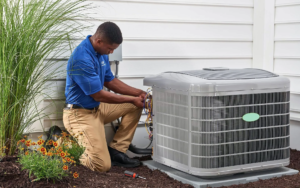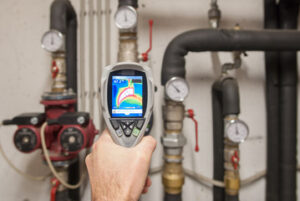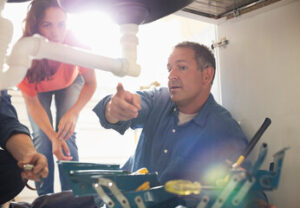Scranton Plumber install and repair pipes, fixtures and appliances that deliver water, drain waste products and regulate indoor climate. Their work significantly impacts daily lives by providing safe and convenient access to water and eliminating deadly diseases spread through contaminated pipes.
Plumbing involves a lot of manual dexterity and strength as well as analytical thinking and problem-solving. Those interested in this trade should be comfortable working outdoors and interacting with clients.

A plumbing system includes pipes, fixtures, appliances, and other components that facilitate the distribution of water, gas, and waste in residential, commercial, and industrial settings. Plumbers install and repair these systems, maintaining them in good condition to ensure a safe environment for occupants. They also work on new construction projects, working from blueprints and architectural plans to design the necessary plumbing infrastructure.
Plumbers must have a strong understanding of engineering and technology to properly maintain these systems, as well as a thorough knowledge of building codes and regulations to ensure compliance with local laws and standards. Additionally, they must be able to troubleshoot problems and find the best solutions for each situation. A high level of attention to detail is essential, as even minor errors can lead to significant issues down the road. Additionally, plumbers often require physical stamina to perform physically challenging labor.
Most states and cities require plumbers to be licensed in order to practice their trade. Qualifications vary, but generally include education and training, on-the-job experience, and passing a written and practical exam. In addition, some plumbers may choose to obtain additional certifications, which can help them improve their skills and make themselves more attractive to employers and clients.
Apprenticeships are a popular way to become a skilled plumber. They combine classroom studies with hands-on training from a certified journeyperson. The wages for an apprenticeship start at about 50 percent of the journeyperson’s hourly rate and gradually increase as the apprentice gains experience and works under supervision.
After completing an apprenticeship, aspiring plumbers must pass a state-approved exam to receive their license. The exam consists of multiple choice questions regarding plumbing codes, rules, and regulations in the city or state where they intend to practice. Additionally, most plumbing contractors must have general liability insurance to protect against property damage or injury while on the job. The cost of these policies varies by state.
Repair
A plumber’s repair services cover everything from fixing leaky faucets to repairing water heaters and even sewage lines. They also offer maintenance services like cleaning drains and installing shut-off valves to prevent major problems from arising. The type of plumbing repair a plumber does will usually depend on the severity and location of the problem. For example, a simple fix for a leaky faucet will cost less than replacing an entire pipe section.
Another common plumbing repair involves clogged drains and toilets. This can be caused by food, hair, paper products or other items that go down the drain and get stuck. Homeowners may be able to remove some of these clogs on their own, but most require professional help to completely resolve the issue. Plumbers can install and replace water filters to improve the quality of home water.
Sewer line repairs are typically a larger project that requires more time and money to complete than other types of plumbing repair. This is because a plumber needs to access the sewer line to find and repair the problem. This can be difficult, as it often involves digging up parts of the yard to reach the clogged or damaged section of the sewer line. Plumbers who specialize in repairing sewage systems have the equipment and skills to dig safely and effectively to restore proper flow of waste in the home.
Other types of specialized plumbing repair include backflow testing, oil-to-gas conversion and fire suppression system installation. These tasks are generally not done by residential plumbers, but rather by industrial or commercial plumbers who have the necessary training and tools to work in these areas.
One of the most important things a plumber can do is to maintain the integrity of a home’s plumbing system. This includes regularly inspecting pipes, cleaning drains and ensuring that all fixtures are working properly. Regular inspections can help prevent major issues from occurring and catch minor problems before they become bigger problems. A plumber can also recommend energy-efficient upgrades for the home’s plumbing and appliances. This can save homeowners money on their utility bills in the long run.
Maintenance
A plumber is responsible for installing, maintaining, troubleshooting, and repairing plumbing systems. These include systems used for potable water, hot-water production, sewage, and drainage. A plumber may work on residential or commercial plumbing systems. While there are many similarities between the two types of systems, a commercial plumber will deal with larger systems than a residential one. Additionally, a plumber who specializes in commercial plumbing will have additional knowledge of large-scale water systems such as those found in hospitals and shopping centers.
While most of a plumber’s duties revolve around identifying and resolving issues, they also perform routine maintenance on plumbing fixtures. This includes replacing washers and gaskets, cleaning drain traps, and ensuring that all faucets, showerheads, toilets, and sinks are functioning properly.
Plumbers use specialized equipment to inspect pipes and assess their condition. This can involve using video cameras to inspect sewer lines, testing pressure levels, and locating leaks. Depending on the results of these inspections, a plumber will determine the best course of action to take.
Plumbing services are available 24/7, which means that emergencies can happen at any time. When this happens, you need a plumber who is available immediately and can respond quickly to resolve the issue. Emergency plumbers should be licensed, insured, and have the experience and expertise to handle a variety of problems.
One of the most important aspects of a plumber’s job is customer service. They must be able to effectively communicate with their clients and explain complex issues in simple terms. They must also be punctual and respectful of their client’s properties.
Plumbers must have excellent technical skills and the stamina to perform physically challenging work. They often spend long periods of time on their feet, climbing up and down ladders, and working in cramped spaces. They must also be able to lift heavy tools and parts. In addition, plumbers must be able to think critically when analyzing problems and coming up with solutions. They must be able to weigh the pros and cons of different options and find the most effective solution for their client.
Home Additions
Whether you want to build an entire new room addition or convert your garage into a mother-in-law suite, a plumber can help. Plumbing contractors will be able to handle the logistics of home additions, including complying with neighborhood zoning ordinances and obtaining the necessary building permits. They can also install the foundation and framing, as well as doors and windows. They can even add heating or air conditioning to the addition, and restore any disturbed landscaping. A quality plumber can also help you choose energy-efficient appliances and fixtures that will save you money on utility bills. They can also ensure that your new addition is watertight and leak-proof. This will protect your property and increase its resale value. It’s a worthwhile investment to make. Besides, you’ll enjoy the extra space in your home.




